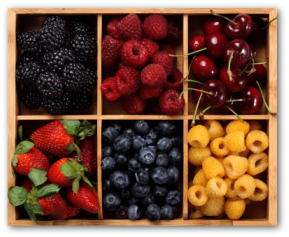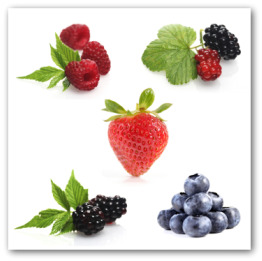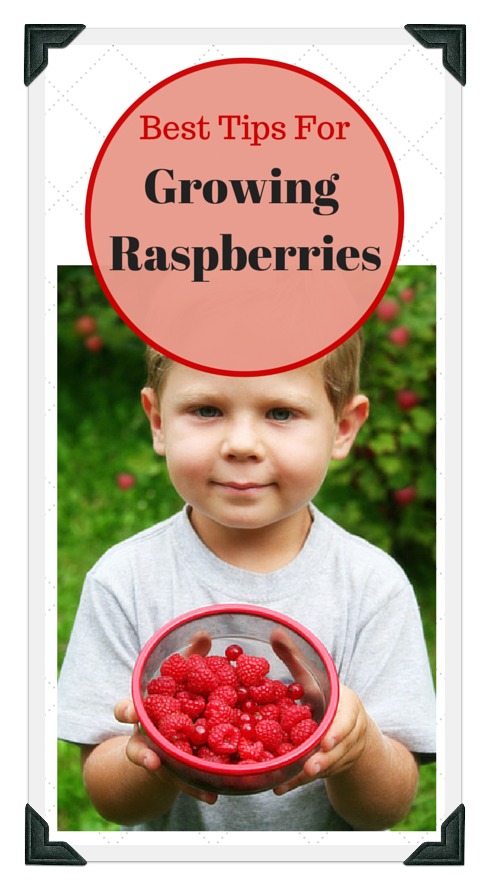Growing Red Raspberries
in Your Home Garden
Here are a few easy tips for growing red raspberries in your home garden!
Learn how to plant, care for, and fertilize red raspberry plants when gardening in your backyard.
When growing raspberries, it is important to handle the bare-root plants with care.
Design Your Own Vegetable Garden Layout Using our Free "Vegetable Garden Planner" Software!
Some plants go into such a deep sleep when they become dormant that they can be pulled from the soil, washed clean, and sold with their roots bare.
Raspberries and other brambles are often purchased with bare roots in late winter and early spring, as are many fruit trees and flowering vines.
If you cannot plant your red raspberry plants right away, lay them on the ground and pile about 4 inches of damp soil or compost over the roots so they will not freeze.
Avid gardeners call this procedure, "heeling out".
To get the plants off to a trouble free start, give them a drink of compost tea.
When you lift out the plants a week or so later, do not be surprised if you see threadlike new roots.
This is a welcoming sign that the plants are emerging from their winter slumber at last!
Download Free Garden Planning Worksheets, Garden Diary, Zone Chart, Or Planting Guide
How to Grow Raspberries Using Compost Tea
Compost tea is the most healthful drink you can provide your red raspberry plants.
It delivers a well-balanced supply of important nutrients to plants and helps them to fend off diseases.
To make compost tea:
1 ½ gallons of fresh compost
4 ½ gallons of warm water
- Pour the water into a 5 gallon bucket.
- Scoop the compost into a cotton, burlap, or panty-hose sack.
- Tie it closed and place into the water.
- Cover the bucket and allow it to steep for 3 to 7 days.
- Pour the solution into a watering can or bucket and give your plants a good drink every 2 to 3 weeks.
10 Tips For Growing
Red Raspberries
- Planting raspberries in a location that receives full sun is best; however if necessary they can be planted in partial shade.
- Red raspberries prefer a well-drained bed with soil of average fertility.
- The ideal pH is around 6.0.
- The plants will tolerate a soil pH range of 5.5 to 7.0.
- Depending on the variety selected, raspberries grow well in Zones 4 to 8.
- Set out bare-rooted nursery plants in spring.
- Red and yellow growing raspberries produce lots of suckers.
- You can dig the suckers up and plant during the growing season when they have developed roots.
- The canes of black raspberries bend to the ground in autumn, and their tips can take root.
- The new plants that form can be dug up and transplanted the following spring.
Planting Tips for Red Raspberries
- Space plants 2 to 3 feet apart in rows 6 to 7 feet apart.
- Set bare-rooted nursery plants so the crowns are just below the soil surface.
- Transplant suckers to the same depth they were growing previously.
- For propagation, growing raspberries can be reproduced from nursery plants or suckers.
- Raspberries are easily propagated by tip layering, division, root cuttings, and hardwood cuttings.

Growing Red Raspberries Tips

- Raspberries are usually trained on trellis or wires. However, you can also plant them in small clumps or in hedgerows.
- Raspberries are prone to viral and fungal diseases. Start with nursery stock that is certified virus-free.
- Make sure that your newly planted raspberry plants receive adequate water, until the roots are well-established.
Raspberry Mosaic Virus
This plant virus that attacks growing red raspberries should be watched out for.
It is often the reason raspberries grow very slowly, show little vigor, and produce berries that fall apart in your hands.
Leaves of infected plants frequently have curled edges, and may show dark green mottled patterns.
The best strategy is to get rid of an infected berry patch and begin a new one in a different location.





